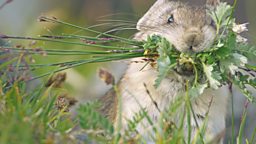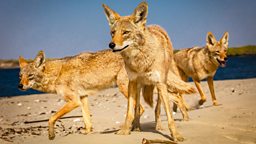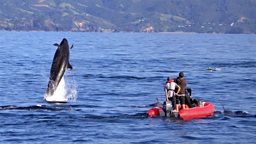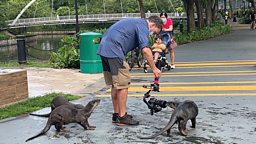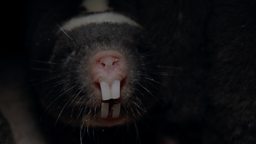Filming chimpanzees through dense forest
By Mammals Cameraman, Tom Ross

To have watched Life of Mammals as a child growing up 20 years ago, the opportunity to film one of our closest mammal relatives, the chimpanzee, for the Forest episode of the latest 麻豆社 Natural History series, Mammals was an honour. There is something about filming a subject that is so expressive, individualistic and humanoid that is just captivating as a cinematographer.
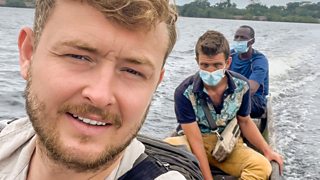
Filming chimpanzees is hard enough at the best of times due to the speed at which some behaviours occur and the distance they cover daily. What really makes it hard though is working in dense forest, where everything wants to sting, bite, burn, spike, cut or obstruct you. Whether it’s your view of a behaviour being obscured, lack of light, getting kit or you caught in vegetation, every step is a potential nightmare.
The chimps that we were filming would cover anything from 6 to 15 miles a day on foot, religiously stopping at midday at a fruiting tree to gorge on its bounty. Covering this kind of mileage, it was paramount that the gear I chose to film with was light enough to haul around all day in a small team and had great low light capabilities to deal with the light availability under the thick canopy. These two factors were a must to make the “rigs” workable day in, day out. That said, due to new technological innovations at the time of filming, we didn’t have to sacrifice on cinematic quality when reducing our camera rig to work through the tight and snaggy forest environment.
To film chimps on the move smoothly through dense and undulating terrain, a new and personally customised gimbal system was used to capture the troop on the march through the forest. With this I was able to follow the troop in their dynamic movements through the vegetation. Moving through dense undergrowth trying not to fall down a hole or trip, operating the camera, composing the shot with the gimbal, floating the rig on the spring arm, being aware of proximity to the chimpanzee and direction, avoiding snagging cables and constantly pulling focus at f2.8 on a moving subject is not the easiest going by yourself! But due to the nature of having to film a solitary chimp, you can’t have more than one person in close proximity to the animal. So, the challenge was not just keeping up with the chimps, it was juggling multiple processes whilst keeping the animal in frame!

The Tilta float system is a Steadicam style setup that utilises a mechanical waist mounted spring-loaded arm to isolate Z axis motion (up and down movement or the appearance of footsteps in footage) and an electronic handheld gimbal to create smooth moving shots. By personally customising this system, I was able to undersling the payload of a DJI RS3, RED Raptor VV 8k and lens to get down to and below the eye level of the chimps. Cinematically or compositionally, this is important for several reasons, as it allowed me to shoot within the chimp’s world as they move through the undergrowth and helps to create an imposing character to the viewer. I chose the RED Raptor VV 8K as the payload camera because combined with “fast glass” it provided just the right amount of flexibility for the ever-changing lighting conditions. When exposed correctly its dynamic range allowed for the image to not “clip” in the highlights through the tree tops whilst retaining the detail in the shadows, especially the dark/black fur of the chimpanzees. Not only that, its vista vision or full frame sensor creates a much nicer and shallower drop off in the focal plane, this is aesthetically much nicer when trying to focus on and isolate your subject within a busy environment.

During the periods the chimps rested, utilising a light weight 200mm lens was also great for picking off portraiture of the group as they went about the social interactions with one another. The system is self-levelling and weight bearing from the hips, so using a longer lens smoothly on the gimbal to get tracking and portraiture shots at a distance was achievable. It allows for creating a dynamic parallax and movement through frame whilst maintaining our distance from the subject, which thankfully, the chimps didn’t mind as they had been studied for over 25 years. This is important as we want the animal/subject to feel comfortable and behave naturally, secondly keeps both parties safe from transmitting zoonotic diseases. We were also filming during Covid, so alongside a 5 day de-worming and isolation period before entering our remote camp, clinical masks were then also crucial to keeping the troop safe.
As with all shoots, weather plays a massive role in both image quality, filming and behavioural availability. Being under a thick canopy light is dramatically reduced even in the least dense areas, so picking a long lens setup to deal with this was important. During the days of better light, the RED Raptor VV 8K combined with the Canon CN20 provided just enough light to pick out key behaviours. That said when a storm rolled in, it was the Sony A7s Mk3 coupled with Atomos Ninja V and Canon CN20 that provided the light in the dark. Without it we would have missed some key behaviours and having that ability to be versatile whilst on remote shoots is key to bringing home all the segments to a great sequence.
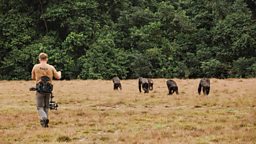
Sometimes though, it’s not just the environment or weather you have to battle with, its remoteness and kit failing. On this shoot I have never experienced so many unfortunate kit related issues in such a short space of time. Even with the support of talented field director Madalena Boto in reality our days on location were limited. This was a second shoot and our last chance to capture key elements of the hunting behaviour we so desperately needed. Remarkably, we could only film for 9 days due to weather, and on those 9 days, the chimps would often disappear over a swamp and an old power system had also fried our equipment. Deep damp forest and electricity are not a match made in heaven. In the first four days generators fried my main camera battery charger, auxiliary equipment chargers and laptop chargers. It was super stressful to organise a remote delivery of new charging equipment and generator. With a bit of selective shooting and organisation via satellite communication though, we managed to hold out until the new equipment arrived. I don’t think I’ve ever been so happy to see a box of cables and chargers!

If it’s not the kit or weather, it’s the subject not playing ball. Thankfully the chimps, other than disappearing over an impenetrable swamp for 2 days, displayed a plethora of behaviours, some of which hadn’t been filmed before. To have captured three different new behaviours on camera, it is exciting as a cinematographer and scientist at heart. Two new hunting strategies and self-medication where amongst the amazing behaviours that I got to witness first hand and record. Proving that chimps really are incredibly versatile, diverse and intelligent in their approaches to finding food sources.
Although seeing and filming new behaviours is always the aim for these types of series, nothing beats filming and learning the characteristics of an individual. Chimps are very special in this sense and after spending a fair bit of time following the alpha male Pandi, it was evident after separating himself from the main troop for days on end that something wasn’t quite right. Alessandra, the key scientist studying the chimps, had noted the disappearance of Pandi’s 14 year old younger brother Ceasar days before his separation and had a theory he was showing signs of grief and mourning. On our penultimate filming day Pandi had taken himself away to nest separately for the night and in doing so the trackers and I stumbled upon what was believed to be Ceasars skeletal remains at the bottom of Pandi’s nesting tree. In moments like that, observing the behaviour of one our closest relatives mourning really hits home and the sensation of being in the presence of a sentient being that isn’t human is very much overwhelming.
I’ve always had a soft spot for the great apes but working on this sequence really opened my eyes to more than just how well adapted chimps are and their intelligence. They are true masters of the forest and hard to film, but their individualism and connections within the troop are very much on an emotional level as much as it is a power hierarchy. I hope the audience enjoys the opening chimpanzee sequence as much as we did filming it.

Chimpanzees look for a forest treat - honey!
A male chimp uses a tool to find honey underground, but doesn't share any with the troop.











